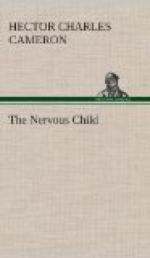In what follows we will consider first the subject of nursery management, searching in it for the origin of the common disorders of conduct both of childhood and of later life. I have grouped these nursery observations under the heads of four characteristic features of the child’s psychology—his Imitativeness, his Suggestibility, his Love of Power, and his acute though limited Reasoning Faculties. I feel that some such brief examination is necessary if we are to understand correctly the aetiology of some of the most troublesome disorders of childhood, such as enuresis, anorexia, dyspepsia, or constipation, disorders in which the nervous element is perhaps to-day not sufficiently emphasised. Finally, we can evolve a kind of nursery psycho-therapeutics—a subject which is not only of fascinating interest in itself, but which repays consideration by the success which it brings to our efforts to cure and control.
CHAPTER II
OBSERVATIONS IN THE NURSERY
(a) the imitativeness of the child
It is in the second and third years of the child’s life that the rapidity of the development of the mental processes is most apparent, and it is with that age that we may begin a closer examination. At first sight it might seem more reasonable to adopt a strictly chronological order, and to start with the infant from the day of his birth. Since, however, we can only interpret the mind of the child by our knowledge of our own mental processes, the study of the older child and of the later stages is in reality the simpler task. The younger the infant, the greater the difficulties become, so that our task is not so much to trace the development of a process from simple and early forms to those which are later and more complex, as to follow a track which is comparatively plain in later childhood, but grows faint as the beginnings of life are approached.
At the age, then, of two or three the first quality of the child which may arrest our attention is his extreme imitativeness. Not that the imitation on his part is in any way conscious; but like a mirror he reflects in every action and in every word all that he sees and hears going on around him. We must recognise that in these early days his words and actions are not an independent growth, with roots in his own consciousness, but are often only the reflection of the words and actions of others. How completely speech is imitative is shown by the readiness with which a child contracts the local accent of his birthplace. The London parents awake with horror to find their baby an indubitable Cockney; the speech of the child bred beyond the Tweed proclaims him a veritable Scot. Again, some people are apt to adopt a somewhat peremptory tone in addressing little children. Often they do not trouble to give to their voices that polite or deferential inflection which they habitually use




